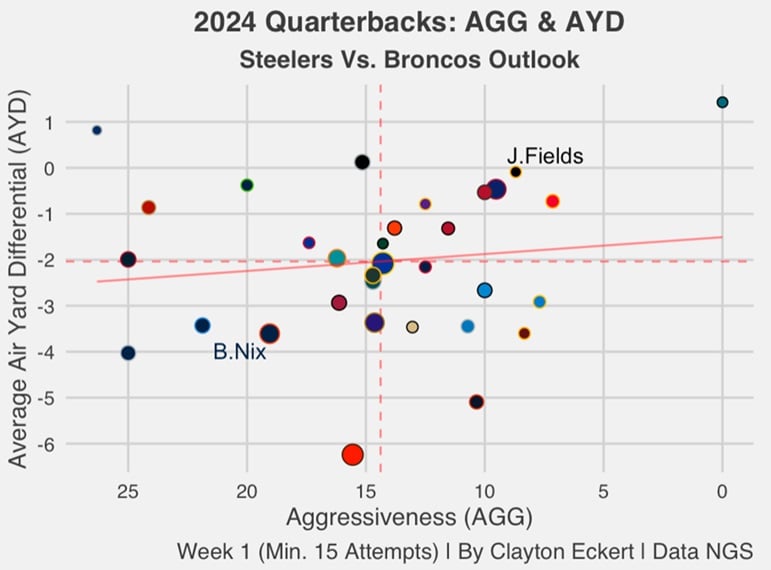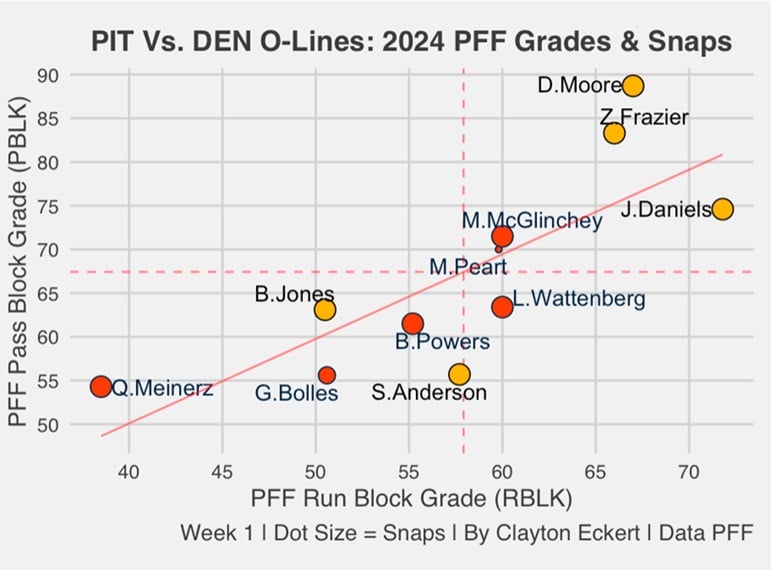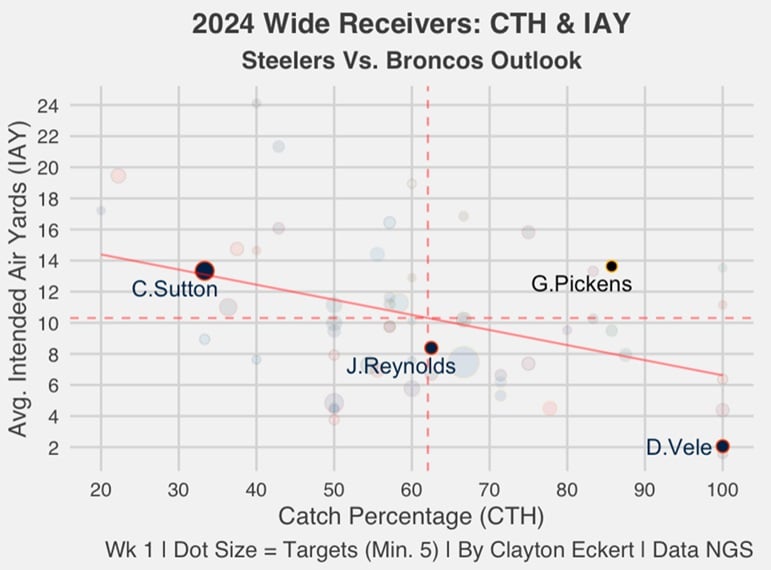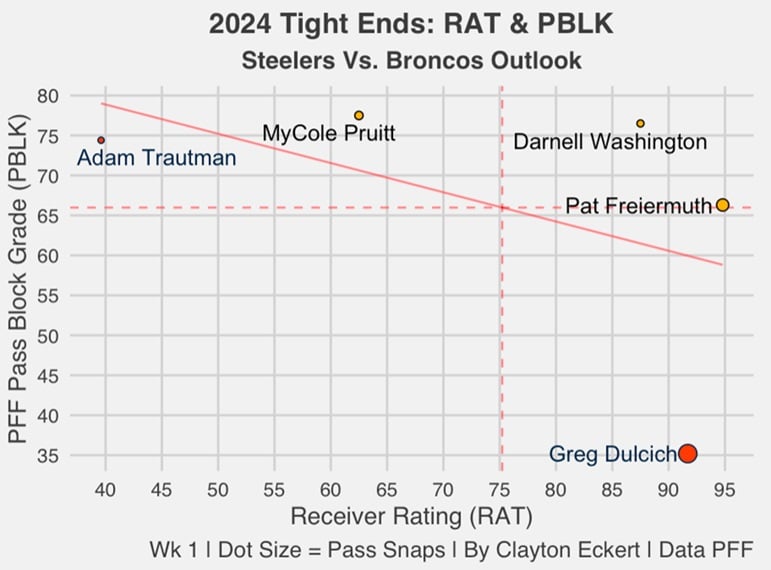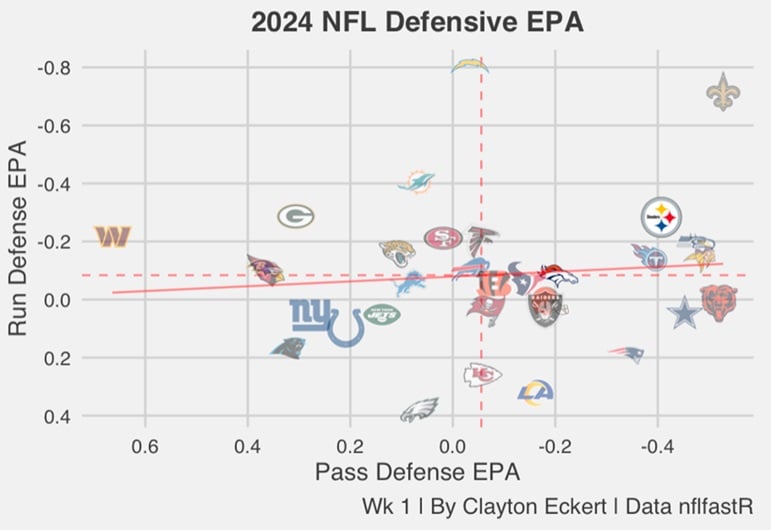The Pittsburgh Steelers (1-0) face off against the Denver Broncos (0-1) for their Week Two challenge.
QB. The main storyline since the 2024 schedule release was QB Russell Wilson’s return to Denver. However, he’s dealt with a calf injury that sidelined him for much of the preseason and the regular season opener. Wilson remained limited in practice and is questionable, with Pittsburgh preceding as if Justin Fields will start on Sunday.
Denver’s rookie QB Bo Nix got his NFL journey underway, going 26/42 (61.9 percent) for 138 yards, no TDs, and two interceptions against the Seattle Seahawks defense, who played a good game. A couple of things stood out when combining Nix’s Week One stats.
Aggressiveness (AGG= rate of all attempts that are thrown into tight windows, where a defender is within one yard) and average air yard differentials (AYD= completed – intended air yards):
Context to some reasons for Nix’s issues, namely turnovers. His 19.0 AGG ranked seventh-most in the opener, meaning he threw into tight coverage often. If a similar story happens on Sunday, Pittsburgh’s strong defense coming off of two picks of their own could feast.
Also, Nix had a -3.6 AYD, the fourth-worst out of the 32 qualifying quarterbacks (min. 15 attempts). More specifically, 2.5 CAY (31st) compared to 6.1 IAY (22nd). So, there were some deeper throws, but he failed to connect on them overall.
On top of this, Nix averaged just 3.3 YPA, next to last among his peers. It didn’t look great, and it will be interesting to see if Pittsburgh can create similar issues for Nix and the Broncos pass game.
Then we see Fields on the ideal flipside, comfortably above average in both data points. A 5.7 CAY (ninth) and 5.8 IAY (26th) made for a -0.9 air-yard differential that ranked fourth. Of course, seeing the IAY number go up as things progress would be ideal.
While it was a conservative game plan, it provided open throws overall and made for a higher-than-expected CAY result. Fields’ 8.7 AGG was fifth-least in the opener, with far fewer tight window throws, and contributed to his high completion rate (73.9-seventh). That is encouraging to Pittsburgh’s identity of taking care of the football, leaning on the defense and the run game.
The latter is a challenge Nix presents, and Pittsburgh has yet to face at QB, which will be interesting to watch play out. Fields, of course, provides a lot with his legs, too, coming off a 57-rush yard game (T-third) on 14 attempts (third), compared to 35 for Nix (ninth) on five runs (T-10th).
This and Pittsburgh’s backfield contributed to the Steelers leading the NFL in rushing attempts (41). Hopefully, the game circumstances allow that formula to continue.
RB. Denver uses a committee in the backfield led by Javonte Williams. He had eight attempts for 23 yards (2.9 YPA). Jaleel McLaughlin led the group in attempts (ten), with 27 yards (2.7 YPA), and a fumble. Pass catching is a forte, catching all five targets but only mustering one yard. Hopefully, Pittsburgh limits them similarly.
Here are RBs efficiency (EFF=distance traveled per rush yards, measures north/south runners) and average time to the line of scrimmage (TLOS) on rushes:
McLaughlin’s low rush yards become evident through the numbers. His 5.9 EFF ranked fourth-worst out of 34 qualifying running backs (min. of ten rushes), one of the most horizontal runners of Week One. The same is true for his 3.3 TLOS, which was the fifth-longest. If it holds true, this could give Pittsburgh’s defense the time to stop the run for several minimal gains.
Harris was also below the mean in EFF (4.9), which ranked 25th among qualifiers. The bigger difference was a quicker 2.7 TLOS that ranked 15th. That is the more important number, in my opinion, encouraging to see Harris in his first opportunity. He looked spry, and hopefully, Jaylen Warren trends that way, with more usage than his two rushes and catches easing back from his hamstring injury.
OL. Obviously crucial to any matchup. Let’s look at PFF blocking grades from the opener:
It was a stronger day for the Steelers offensive line, while the Broncos struggled overall. Included was allowing the most pressure of any offensive line in Week One.
The guiltiest was LT Garett Bolles, charted for five pressures allowed (T-sixth most). 55.6 PBLK and even lower 50.6 RBLK. Matt Peart was next man up upon Bolles’ in-game injury ankle, but trended well and set to play. Like Steelers EDGE Alex Highsmith’s matchup here.
Here’s the rest of Denver’s unit:
LG Ben Powers (61.5 PBLK, 55.2 RBLK).
C Luke Wattenberg (63.4 PBLK, 60.0 RBLK).
RG Quinn Meinerz (54.3 PBLK, 38.5 RBLK).
RT Mike McGlinchey (71.5 PBLK, 60.0 RBLK).
Denver’s guards allowed quite a bit of pressure, and face a Steelers front that was a wrecking crew in the opener. Huge key that Pittsburgh hopefully wins with Cameron Heyward and company, who graded as the best interior linemen against the run last week (81.6).
The Broncos’ lowest individual blocking grade was Meinerz 38.5 RBLK, and could be a chess match the Steelers try to exploit. Their best run block grade was 60.0, reemphasizing a poor rushing effort of just 99 yards, led by Nix at QB (35 yards). Keep it going, Pittsburgh.
McGlinchey was graded as their best pass blocker by far (71.5), along with tying for their best, but not ideal 60.0 RBLK. He faces Mr. Elite in Steelers EDGE T.J. Watt, and expect another dominant showing.
Now for Pittsburgh’s offensive line:
LT Dan Moore (88.7 PBLK, 67.0 RBLK). This PBLK that ranked third-best among tackles in the opener is a fantastic sight, after being one of the worst pass-blocking tackles in 2023. Great job.
Rookie C Zach Frazier (83.3 PBLK, 66.0 RBLK) thankfully looked like a solid vet in his debut. He tied for the second-best PBLK at his position and showed grown-man strength/impact that hopefully continues. I thought both of their RBLK deserved to be higher, too.
RG James Daniels (74.6 PBLK, 71.8 RBLK). He had the best-balanced grades in the matchup, the only linemen above 70 in each, and the best RBLK. He showed some refreshing nastiness there, playing to Pittsburgh’s desired identity. More, please.
Now, the less desirable performances. RT Broderick Jones (63.1 PBLK, 50.5 RBLK) continued to struggle, unfortunately, including two sacks allowed. Rookie Troy Fautanu is now healthy, and it will be interesting to see if he gets the nod over Jones, who’d likely go to the bench considering Moore’s strong play thus far.
Denver EDGE Jonathon Cooper graded as their best defender in the opener, including a whopping seven total pressures (T-fifth most), and some solid run defense. He played strictly on this side of the formation and could be a handful for whichever Steeler plays.
LG Spencer Anderson (55.7 PBLK, 57.7 RBLK) will once again fill in for the injured Isaac Seumalo (pec-ruled out). Hoping that Anderson shows more comfort following his first NFL start, trending positively compared to some weaknesses that included two QB hits and a penalty.
Denver had three players with at least eight targets: Courtland Sutton (11), Josh Reynolds, and Devaughn Vele, both getting eight. Each was held to under 50 yards, compared to Pittsburgh’s George Pickens (85) on seven targets. Two targets were the most for any other Steelers WR. Being able to run often is a factor, but we saw the expected in Pickens dominating the passing volume.
Here are catch rates (CTH) and average intended air yards (IAY):
Sutton’s low 33.3 CTH was staggering as he struggled to connect with Nix. The quarterback is one factor, including both interceptions intended for Sutton and a turnover-worthy play. Sutton also had a drop, and it will be interesting if similar issues occur against Pittsburgh. He had their highest 13.3 IAY, ranking 15th (57 qualifiers), and his talents will be challenging.
Pickens lands above the mean in both and topped Sutton with a 13.6 IAY (13th). He caught almost everything, displaying his fantastic receiving skills including some improbable grabs for an 80.0 CTH (12th). Great reliability and impact that hopefully remains consistent.
Vele had a perfect catch rate on eight grabs but on the second-least air yards among qualifiers. He’s the only Bronco ruled out, leaving a void as Nix’s most consistent target thus far. Reynolds 8.4 IAY was second on the team, below the mean and 35th of qualifiers, and average in CTH (62.5, T-23rd). I really like the chances for another great day for Pittsburgh’s defense.
TEs were quiet as receivers overall. Pittsburgh’s Pat Freiermuth had the most targets (four) and yards (27), while MyCole Pruitt and Darnell Washington had a catch each and combined 14 yards. Broncos Greg Dulcich led the team with two catches on as many targets for 12 yards. Both teams will likely try to get more impact from the position.
Let’s look at TEs in the passing game, viewing receiver rating (RAT= QB rating when targeted) and PFF pass-blocking grades (PBLK):
Pittsburgh’s PBLK stands out positively. Pruitt (77.5) and Washington (76.5) ranked second and third league-wide, respectively, while Freiermuth wasn’t bad either (66.3) despite being more of a receiver. It could prove huge against Cooper and other Broncos pass rushers.
Freiermuth led the way with a 94.8 RAT (22nd), Washington at 87.5 (29th), and Pruitt’s 62.5 was the lowest Steelers TE by far (41st). Not to the extreme of Denver’s Adam Trautman (39.6), the sixth-worst of 59 qualifiers with one target but no catches. His impact was a 74.4 PBLK, perhaps pointing to a role in helping on Watt and other Steelers.
On the other side of the visual was Dulcich, tying for 24th in RAT (91.7) but sixth-worst 35.2 PBLK. Receiving could show up more with Vele out.
Defense. Expected points added is a great stat, measuring the value above/below expectation per play. Here are Week One defensive results against the pass and run:
Pittsburgh was above the mean in each in the opener, thankfully. Run defense was the strongest (fifth) and ranked sixth against the pass. Ecstatic they came out the gates so well, and hopefully show the consistency needed for the 2024 Steelers’ success again.
Denver’s pass EPA ranked respectively (ninth) but were average against the run (16th). They allowed 146 rushing yards including 2/3 explosive plays allowed. It aligns with Pittsburgh’s offensive identity, and knock-on-wood plays out that way to a victory.
Opponent-Scouting-Reports: Offense Defense
Injury-Reports: Steelers Broncos
Thanks for reading and let me know your thoughts in the comments.


